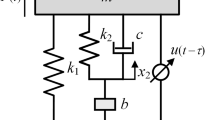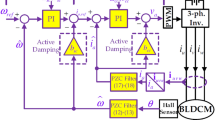Abstract
Basic learning control law designs are summarized, and conditions for convergence of the learning process are developed when several different choices of filter frequency cutoffs are used for robustification. This paper presents a cliff harmonic-frequency filter with a sharp frequency cutoff and a weighted harmonic-frequency filter with frequency weighting, that are applied each iteration in iterative learning control. Filter matrices based on the state-space model of a finite-difference digital filter are derived for Matlab’s and Gustafsson’s forward and backward filtering which are commonly called filtfilt methods. Furthermore, filter matrices for Matlab’s and Gustafsson’s filtfilts are revised to make the input convergence matrix to be monotonically stable. Numerical examples are used to demonstrate the effectiveness of the harmonic-frequency filters comparing with Matlab’s and Gustafsson’s filtfilt methods based on Butterworth filters of different orders and cutoff frequencies. It is found that the singular values of filter matrices are related to the squared amplitude of the Butterworth filter at harmonic frequencies.









Similar content being viewed by others
References
Ahn, H.S., Chen, Y., Moore, K.L.: Iterative learning control: brief survey and categorization. IEEE Trans Sys Man Cybern Part C (Applications and Reviews) 37(6), 1099–1121 (2007)
Bien, Z., Xu, J.X. (eds.): Iterative Learning Control: Analysis, Design, Integration and Applications. Springer Science & Business Media, Berlin (2012)
Bristow, D.A, Tharayil, M., Alleyne, A.G.: A survey of iterative learning control. IEEE Control. Syst. Mag. 26(3), 96–114 (2006)
Elci, H., Longman, R.W., Phan, M.Q., Juang, J.-N., Ugoletti R.: Discrete frequency based learning control for precision motion control. Proc IEEE Int Conf Sys Man Cybern 3, 2767–2773 (1994)
Elci, H., Longman, R.W., Phan, M.Q., Juang, J.-N., Ugoletti, R.: Simple learning control made practical by zero-phase filtering: applications to robotics. IEEE Transations on Circuits and Systems —I: Fundamental Theory and Applications 49(6), 753–767 (2002)
Edwards, S.G., Agrawal, B.N., Phan, M.Q., Longman, R.W.: Disturbance identification and rejection experiments on an ultra quiet platform. Adv. Astronaut. Sci. 103, 633–651 (1999)
Ahn, E.S., Longman, R.W., Kim, J.J., Agrawal, B.N.: Evaluation of five control algorithms for addressing CMG induced jitter on a spacecraft testbed. J. Astronaut. Sci. 60(3), 434–467 (2015)
Åström, K., Hagander, P., Strenby, J.: Zeros of sampled systems. In: Proceedings of the 19th IEEE Conference on Decision and Control, pp 1077–1081 (1980)
Gustafsson, F.: Determining the initial states in forward-backward filtering. IEEE Trans Signal Process 44(4), 988–991 (1996)
Mitra, S.K.: Digital Signal Processing, 2nd edn. McGraw-Hill, New York (2001)
Oppenheim, A.V., Schafer, R.W., Buck, J.R.: Discrete-Time Signal Processing, 2nd edn. Prentice Hall, Upper Saddle River (1999)
MALAB and Simulink are registered trademarks of the MathWorks, Inc, 1984-2020, Ver. R2020a
Song, B., Longman, R.W.: Circulant zero-phase low-pass filter design for improved robustification of iterative learning control. Adv. Astronaut. Sci. Astrodyn. 156, 2161–2180 (2016)
Isik, M.C., Longman, R.W.: Explaining and evaluating the discrepancy between the intended and the actual cutoff frequency in repetitive control. Adv. Astronaut. Sci. 136, 1581–1598 (2010)
Plotnik, A.M., Longman, R.W.: Subtleties in the use of zero-phase low-pass filtering and cliff filtering in learning control. Adv. Astronaut. Sci. 103, 673–692 (2000)
Bao, J., Longman, R.W.: Unification and robustification of iterative learning control laws. Adv. Astronaut. Sci. 136, 727–745 (2010)
Longman, R.W., Li, T.: On a new approach to producing a stable inverse of discrete time systems. In: Proceedings of the Eighteenth Yale Workshop on Adaptive and Learning Systems, Center for Systems Science, New Haven, Connecticut, pp 68–73 (2017)
Juang, J.-N., Longman, R.W.: Identification of the dynamics in the singular vectors of the system Toeplitz matrix of Markov parameters. Adv. Astronaut. Sci., (in press) (2021)
Author information
Authors and Affiliations
Corresponding author
Additional information
Publisher’s Note
Springer Nature remains neutral with regard to jurisdictional claims in published maps and institutional affiliations.
Rights and permissions
About this article
Cite this article
Juang, JN., Longman, R.W. Iterative Learning Control Inverse Problem Using Harmonic Frequency Filters. J Astronaut Sci 68, 677–694 (2021). https://doi.org/10.1007/s40295-021-00273-0
Accepted:
Published:
Issue Date:
DOI: https://doi.org/10.1007/s40295-021-00273-0




